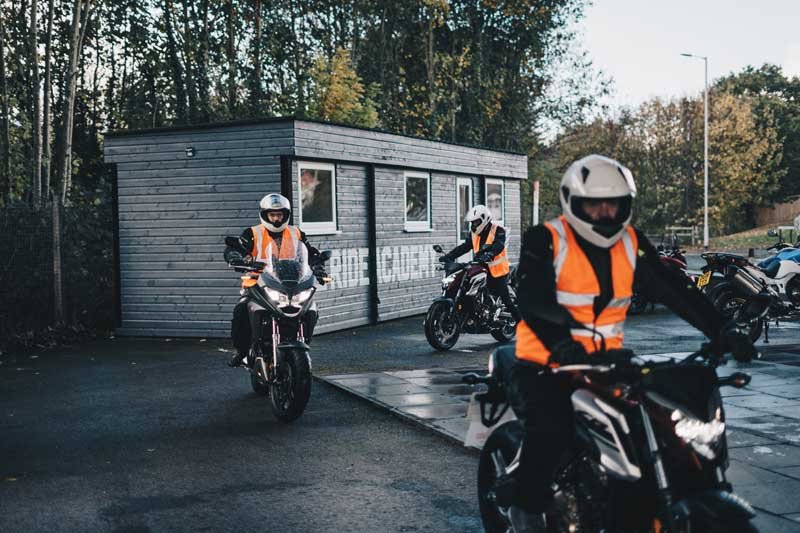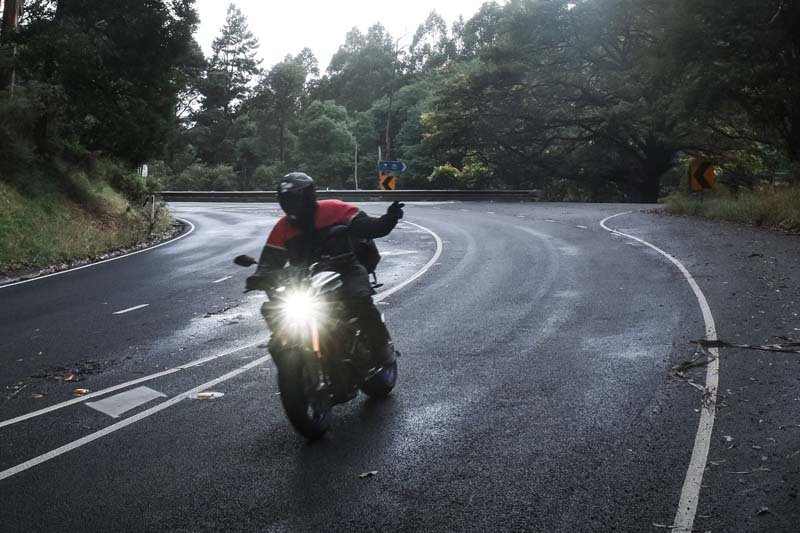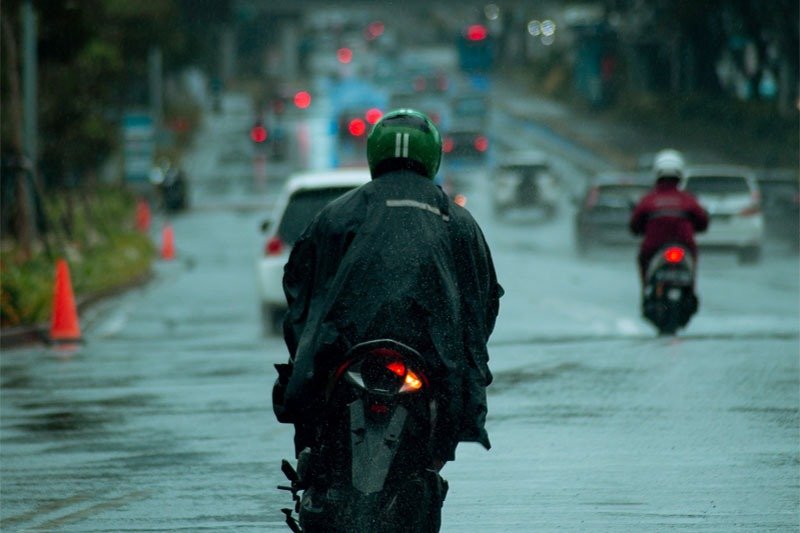Motorcycle safety relies on mirrors for riders to keep tabs on what's going on around them. Yet, not every mirror cuts it the same way. Riders have long been bickering over which is better: bar end mirrors or the stock mirrors. They argue about which (Bar End Mirrors vs Stock Mirrors) gives a better view, […]

10 Safety Tips For Riding A Motorcycle In The Rain
Rainfall is unavoidable.No issue just how careful you have to do with checking out the projection prior to your ride, you're bound to have run into rainfall during one of your trips. Rather than attempting to prevent it, you can make it less unpleasant by being prepared both physically and mentally by merely comprehending a couple of useful methods to ride safely.
Here are 10 essential tips for riding a motorcycle in the rain.
Table of Contents
1. Avoid Riding Immediately After It Rains
Roads are slickest when the rain first begins, particularly if it hasn't drizzled in a while. The initial 15 mins of rain are the worst. That's because oil, fluid, fuel, and also muck are deposited on a roadway's surface in time. When it rains, these deposits mix with the water and rest on the road surface making riding more treacherous. These deposits are usually distributed as well as gotten rid of after 15 minutes-- if you are on the roadway when it begins belting down, consider pulling over and waiting it out for 15 minutes. If you can not put your ride off, at least be additional vigilant that roadway surface areas will certainly be specifically slick throughout this time.
2. Prepare Your Motorcycle
-
Tires
Evaluate the PSI and tread of your tires before riding. Guarantee their pressure is suitable for your motorbike. A heavy rainstorm is not the moment to attempt your luck with a low-air or punctured tire.
Your tires require to be ready to direct water, when water remains in the means, tire walk disperses it-- very normally, the extra tread the less water in the means as well as the more traction.
-
Brakes
Your brake pads need to have plenty of brake material to stop as needed throughout wet weather.
-
Gas level
Ensure you have lots of gas in your storage tank prior to your ride in the rainfall and make certain that there is no leakage. Running out of gas during a tornado or downpour is not suitable. An oil leakage might create a significant security problem, when oil is mixed with water, it ends up being a dish for unsafe, risky problems that can end your ride early.
-
Lights and reflectors
See to it all fronts lights, taillights, and blinker lights are functioning properly and that no light bulbs are out. Check that all reflectors are intact-- they will certainly contribute throughout periods of low visibility.

3. Choosing The Right Gear
A made-for-motorcycling rain suit is a rider "essential". A rain-suit or all-weather riding jacket and trousers and waterproof gloves, as well as waterproof boots, are necessary if you're most likely to be riding distances or even traveling.
In terms of garments, there is a wide variety of waterproof alternatives readily available. One of the most essential aspects of motorcycle garments is to ensure that it all fits effectively.
A layer that is as well big will enable water in. Gloves that are baggy will permit water that flows down your sleeves into them as well as Boots that are also big will certainly do the very same too.
All this indicates you'll feel uneasy in the wet and also if you're wet, you'll get chilly. It's the wind chill we're revealed to. When you're chilly, you won't assume straight as well as this will certainly end up interfering with your functional skills and awareness. Cold is a distraction. Consequently, it's crucial that your garments are not just waterproof but fit well as well.
Rainfall conditions are infamously dark as well as depressing, and it's easy to mix right into the road. It makes it even harder than common for vehicles to see you. Put on intense gear for far better exposure. Make on your own seen with intense shades as well as reflective surface areas.
Use a waterproof bag or pocket for anything that could get damaged by water, like your mobile phone or electronic devices. Even cases that are advertised as water-resistant can result in a loss if water infiltrates the case. Much better to be risk-free than sorry.

Fodsports Waterproof Bluetooth Intercom
4. Anti-Fogging Treatments
Fogging occurs when there is humidity and a temperature level distinction on either side of the things. Consequently, Rainfall, as well as moisture airborne, can trigger your safety glasses, helmet visor, and also your windscreen to fog up throughout a rainstorm. While using your helmet, think about keeping your visor open for airflow and also to avoid it from misting up. Never ever attempt to ride with a fogged-up helmet. The use of fog preventives is the best option. If you experience a scenario where fogging is inescapable, pull over until problems are more secure.
5. Slow And Extra Braking Distance
Slow down. If you are riding in the rain, you need to slow down. Allow extra braking distance in between you and also others when driving Quitting distances enhance in damp weather, so increase the buffer area in between your bike as well as various other vehicles. Additionally, remember that you will require additional range to stop when coming close to a junction. Dry pavement is ideal for stopping, but damp roads enhance quitting distances dramatically.
So slow down In order to stay risk-free and offer on your own (and also others) sufficient time to make decisions.
6. Braking
Following on from being observant is braking-- the quicker you see hazards and edges, the earlier and also a lot more efficiently you can use your brakes.
The key to effective stopping in the damp is to do so efficiently and also progressively. This will certainly stop your tires from shutting out which, in the damp, is integral to risk-free riding.
If you need to apply your brakes all of a sudden, pump them in order to stop hydroplaning. Do not apply simply your front brakes as it can trigger you to blow up the front wheel.
Apply an extra back brake than typical. If your front wheel starts skidding, you are in a problem. If your back wheel does, you can always remedy it.
7. Maintain a calmness
Maintain a calm, kicked-back stance. Tightening your muscular tissues will your mind and body strain, and also could make you panic about changing scenarios. If you're tense and rigid on your bike you'll battle to ride efficiently and that is just one of the secrets to riding securely in the rainfall.
Try to maintain your muscular tissues kicked back and also maintain a typical posture. Do not sit also upright as well as loosen up-- in this way, any loss of grip will certainly not result in full-body, jerky motions that considerably affect your handlebars and also bike control. Like the suspension, if you're loose, any kind of unexpected slips, slides, and also jerks will certainly be taken in.

8. Beware Of Hazards On The Road
-
Shiny-smooth Surfaces
Roadway markings, manhole covers, and also smooth road surface areas will certainly all be a lot more treacherous to ride on in the wet. It's straightforward physics-- any type of surface that is not porous will certainly be slippery to ride across as the water that falls on them has no place to go and also it rests on the surface.
Attempt to avoid riding over them as high as feasible as well as, if slippery surfaces are unavoidable, try to ride throughout them in a straight line, prevent braking on them as well as maintain the bike as upright as possible.
-
Pits And Puddles
Keep an eye out for puddles and also avoid riding through them. Riding through pools can create mud as well as rocks to hit your visor, making it impossible to see. Puddles can mask pits as well as damage to the surface area of the roadway. In addition, you never know just how deep a split or pool is under the water. Avoid damaging or wrecking your motorbike by preventing them.
-
Oil residue
Never drive with oil spills on the road. The one advantage of riding in the wet is that it's often extra identifiable as oil gives off a rainbow-colored shine on a road's surface area. If a spill is inevitable, safely minimize your rate as much as you can to stay clear of sliding.
Be observant. The quicker you see puddles, unsafe roadway markings, and oil spills, the even more time you have to change and reduce their impact.
9. Seek Dry Lines
While riding, remain in the dryest lane feasible, Dry sidewalk offers premium traction and the ability to move, so ensure you consistently place yourself in the driest area of the lane. Search for parts of the road that lorries have actually currently taken a trip on, try riding in the tire tracks of automobiles before you. While searching for completely dry lanes, keep in mind that you ought to still prevent blockages as well as other dangers. Huge semi-trucks are specifically worth staying clear of, as they can spray your visor or windscreen with dust as well as particles.
10. Never ride in a thunderstorm
Look out for lightning and carry it out sideways of the roadway if you see it. Lightning might just seek out tall items, yet that electrical power has to go someplace in the ground. If every little thing is wet, including yourself, your tires aren't definitely most likely to shield you from power traveling along the ground. Find sanctuary, but not under a tree! Now is a blast to manage and also have a mug of coffee.

Although it's occasionally inescapable, riding your motorcycle in the rainfall can be hazardous for the following factors:
- Decreased presence: Heavy rain, fog, mist as well as overcast skies all create decreased visibility for you as well as everybody else when driving.
- Unsafe roads: Water, oil, and also mud all contribute to slick, harmful roadways during rainstorms. If temperature levels are reduced enough to trigger cold, rain can likewise resort to ice.
- Hydroplaning: Motorcyclists go to the threat of hydroplaning throughout heavy rainfall. They are additionally subjected to other cars that may also hydroplane, more worsening road conditions, and also decreasing exposure.
- Storm conditions: If hefty rainfall is accompanied by rumbling, lightning, solid winds, and also hail storm, motorcyclists go to an increased risk and also needs to stay clear of driving. If currently when driving, seek shelter as quickly as safely possible.
- Blockages and barriers: Hefty rainfall can clean debris and also other obstructions into the street, resulting in other barriers, like fallen trees or landslides. Integrated with decreased exposure, these challenges can come to be exceptionally hazardous to all travelers.
Learn More Safety Riding Tips
▪️Safety Tips For Riding A Motorcycle In Wind
▪️Tips For Riding Motorcycles In Hot Weather
▪️Safety Tips For Riding A Motorcycle In The Fog
▪️Top 11 Tips For Riding Safely In Heavy Traffic

Motorcycle mechanic, writer. Interested in motorcycle gear for years. Like to stay up to date with the newest products and techniques of the motorcycle.
Picking the perfect brake pads for your ride has an influence on how safe you are, how well your whip handles, and what you’ll shell out over time. You’ve got a whole menu, from wallet-easy organic pads to fancy ceramic or semi-metallic types. To get why budget brake pads ain't the same as the pricier […]
E-bikes have transformed into more than just gadgets to help you get around. Now, they're speed demons that can go toe-to-toe with motorbikes. It’s 2025, and these speedy machines have gotten a huge boost from better motors, more powerful batteries, and sleek designs that cut through the air like a knife. Let’s dive into the […]
Many riders who aren't so tall or ladies just starting to ride bikes need to pick out the best Motorcycles for Short Riders and Women. They gotta look for three key things: a seat that's not too high up, a bike that's not too heavy, and something that looks good enough to give them confidence. […]
As we accelerate into 2025, motorbikes are getting a serious tech upgrade. They’re all about safer rides and more fun on the road. Even if you’re a pro or just starting, kitting out your two-wheeler with cool tech stuff is a game-changer. Check out these ten top motorcycle gadgets each motorcyclist will want in 2025. […]
Getting around the city every day can be super annoying. You've got traffic like molasses nowhere to park, fuel prices through the roof, and buses stuffed like sardine cans make heading to the office a real pain. For loads of folks, getting a motorcycle is a pretty slick move—they’re nimble, cost-effective, and perfect for squeezing […]

